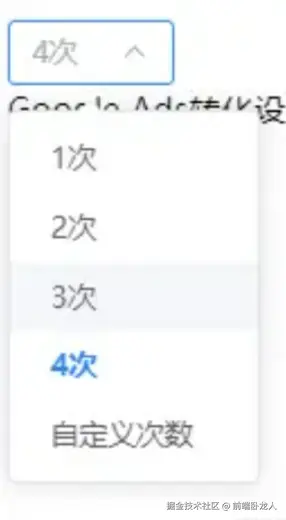前言
最近公司产品要求要一个自定义输入的下拉框组件,如下图,项目使用 Element Plus+vue3,可以对其element进行二次封装

以下是如何基于 Element Plus 的 el-select 组件实现一个带有自定义输入功能的下拉框组件的详细步骤。
一、组件功能需求
- 基本下拉选择 :
- 提供一个下拉框,用户可以从预定义的选项中选择值。
- 自定义输入 :
- 当用户选择"自定义"选项时,显示一个输入框,允许用户输入自定义值。
- 输入完成后,用户可以通过点击"确认"按钮将自定义值添加到下拉框的选项中。
- 动态宽度调整 :
- 根据当前选中的值(包括自定义值)动态调整下拉框的宽度,确保显示效果良好。
- 数据回显 :
- 当用户从下拉框中选择或输入自定义值后,能够正确回显到界面上。
二、实现思路
(一)组件结构
- 使用
el-select和el-option构建基础的下拉框。 - 在下拉框中添加一个"自定义"选项,其值设为
0。 - 当用户选择"自定义"选项时,通过
v-if控制显示一个输入框和"确认"按钮。
(二)逻辑实现
- 输入框的显示与隐藏 :
- 使用
v-if控制输入框的显示状态。 - 在下拉框的
change事件中判断用户是否选择了"自定义"选项,如果是,则显示输入框并聚焦。
- 使用
- 动态宽度调整 :
- 使用 CSS 和 JavaScript 动态计算下拉框的宽度,确保在不同状态下(如显示自定义输入框时)宽度合适。
- 数据回显 :
- 使用计算属性或方法将自定义输入的值添加到下拉框的选项中。
- 监听
el-select的v-model值变化,动态调整下拉框的选项列表。
(三)代码实现
1. 模板部分
vue
<template>
<div>
<el-select
v-model="value"
placeholder="请选择"
class="relative"
:style="{ width: selectWidth }"
@change="handleSelectChange"
@visible-change="visibleChange"
>
<el-option
v-for="item in options"
:key="item.value"
:label="item.label"
:value="item.value"
/>
<el-option
key="custom"
label="自定义"
:value="0"
/>
</el-select>
<div v-if="showInput" class="input-container absolute">
<el-input
ref="inputRef"
v-model="customValue"
placeholder="请输入自定义值"
style="width: 80px; margin-right: 16px;"
/>
<el-button type="text" @click="addCustomOption">
确认
</el-button>
</div>
</div>
</template>2. js部分
vue
<script>
import { ref, watch, nextTick } from 'vue';
export default {
setup() {
const value = ref(null);
const options = ref([
{ value: 1, label: '选项1' },
{ value: 2, label: '选项2' },
{ value: 3, label: '选项3' },
]);
const showInput = ref(false);
const customValue = ref(null);
const inputRef = ref(null);
const selectWidth = ref('120px');
// 处理下拉框选择变化
function handleSelectChange(val) {
if (val === 0) {
showInput.value = true;
customValue.value = null;
adjustSelectWidth(val);
nextTick(() => {
inputRef.value.focus();
});
} else {
showInput.value = false;
adjustSelectWidth(val);
}
}
// 添加自定义选项
function addCustomOption() {
if (customValue.value !== null) {
const customLabel = `自定义(${customValue.value})`;
options.value.push({ value: customValue.value, label: customLabel });
value.value = customValue.value;
showInput.value = false;
}
}
// 动态调整下拉框宽度
function adjustSelectWidth(val) {
const tempDiv = document.createElement('div');
tempDiv.style.position = 'absolute';
tempDiv.style.visibility = 'hidden';
tempDiv.style.width = 'auto';
tempDiv.style.fontSize = '14px';
document.body.appendChild(tempDiv);
tempDiv.innerHTML = getLabel(val);
selectWidth.value = val ? `${tempDiv.clientWidth + 60}px` : '120px';
document.body.removeChild(tempDiv);
}
// 获取标签文本
function getLabel(val) {
const option = options.value.find(option => option.value === val);
return option ? option.label : '';
}
// 监听下拉框显示状态
function visibleChange(val) {
if (val) {
showInput.value = false;
}
}
// 确保动态值在选项中存在
function ensureValueInOptions(val) {
if (!options.value.some(option => option.value === val)) {
val && options.value.push({
value: val,
label: getLabel(val),
});
}
}
watch(
() => value.value,
(newVal) => {
ensureValueInOptions(newVal);
adjustSelectWidth(newVal);
},
{ immediate: true },
);
return {
value,
options,
showInput,
customValue,
inputRef,
selectWidth,
handleSelectChange,
addCustomOption,
adjustSelectWidth,
visibleChange,
};
},
};
</script>3. 样式部分
vue
<style scoped>
.input-container {
display: flex;
align-items: center;
border-radius: 8px;
background: #fff;
box-shadow: 0px 4px 4px 0px rgba(0, 0, 0, 0.12);
padding: 15px;
z-index: 9999;
}
// 样式穿透
::v-deep(.el-input__wrapper) {
box-shadow: none;
}
</style>三、总结
通过上述实现,我们成功构建了一个带有自定义输入功能的下拉框组件。它不仅支持从预定义选项中选择值,还允许用户输入自定义值,并动态调整下拉框的宽度以适应不同场景。
这种组件在实际开发中非常实用,能够满足复杂的用户交互需求,后续其他地方进行复用也是非常不错的。